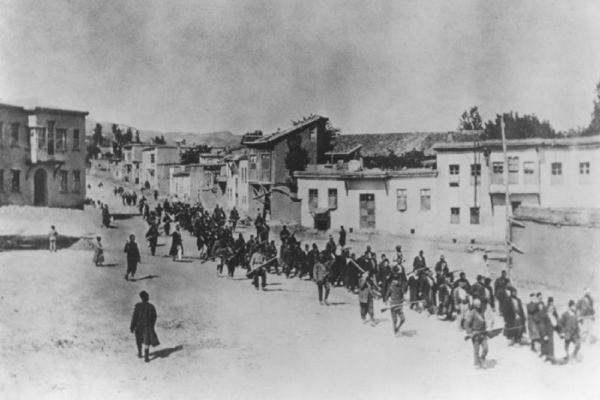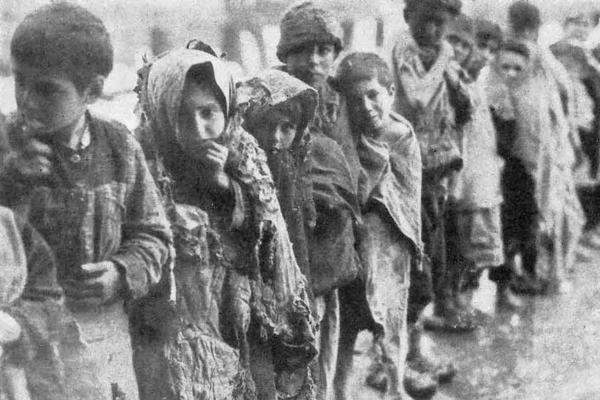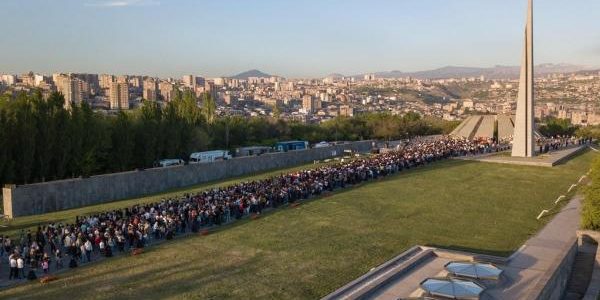110 years ago, the world witnessed one of the most tragic pages in human history – the Armenian Genocide in Ottoman Turkey. This tragedy not only took the lives of two million innocent people, but also left a deep mark on the souls of the survivors, shaping their identity and desire for justice.
First Evidence
In December 1914 – January 1915, in the Sarikamish operation, the Russian Caucasian Army defeated the 3rd Ottoman Army and stopped the Turkish advance on Kars. By the end of March 1915, the Russian army continued its victorious advance deep into Turkey. The occupation of a vast territory and the sweet feeling of military glory hovered in the ranks of the Russian troops, but something terrible and unimaginable was happening underneath. There was a massacre, a merciless extermination of an entire people, sanctioned by the Turkish authorities.
Here and there the Russian soldier encountered corpses and the remains of women and children. Soldiers and Cossacks, following in the footsteps of the retreating Turkish troops, found only mutilated corpses and burnt houses of Armenians. The few remaining survivors, as the Kuban Cossack officer Fyodor Eliseev described in his memoirs, tearfully kissed the stirrups of the horses of the Russian saviors.
From the very first days, Russian soldiers and officers witnessed the cruelties and atrocities committed by the Turks and Kurds. They wrote about the events on the Turkish front in their letters, describing the horrors committed by the Turks against the peaceful Armenian population. These letters were the first written eyewitness accounts of the genocide of the Armenian people in Turkey.
“During all the campaigns from Turkey to Persia and back, I had to see several times the terrible pictures of the suffering of the unfortunate Armenians. The embittered Turkish troops, with their frequent failures in battles with our troops, try to vent their failures on the defenseless Armenians. And what tortures they do not subject these people to. In their intrigues against the Armenians, the Turks do not stop at any terrible methods of inflicting the greatest possible slow torture. They do not spare not only men or women, but even children… Pictures of this kind chill the blood. “The hair stands on end at the sight of such a terrible execution-reprisal of a strong man against a weak, defenseless one… And how soon will the righteous right hand punish these beast-monsters?” writes the senior sergeant of the 4th company of the No. 10th regiment Ivan Shamalov (“Kuban Cossack Herald”, 1915, No. 40, pp. 6-7).
Invaluable evidence was left in his notes, published under the title “Cossacks on the Caucasian Front in 1914-1917”, by Colonel of the Kuban Cossack Army Fyodor Eliseev. Here is how he described the entry of a Cossack unit into an Armenian village devastated by the Turks:
“We jumped into the village. It turned out to be Armenian. There were only women and children in it. None of them were crying, but howling like animals and crossing themselves, saying: “Christine! Christine! Irmyan Christine!” You can’t understand anything from them about the events that took place in the village. I calm them with a gesture of my hand. The Eastern world is malleable. And believing in something higher, fatally believing, I took off my papakha and crossed myself, showing them that they were now under the protection of Russian weapons. And without stopping, we set off south. And a verst later, by a stream, we saw up to ten Armenian corpses. Now the reason for the sobbing and gnashing of teeth of the women in the village became clear to us. All the corpses were still fresh. All their hands were tied behind their backs. And all with their throats cut. Their clothes were set on fire and still smoldering. All were young guys with barely visible black moustaches. It was a terrible picture. The Cossacks looked at them in silence. And for them, as Christians, the face of war was changing. They hated the enemy and thirsted for revenge.”

Causes of the Genocide
The causes of the Armenian Genocide in Ottoman Turkey were multifaceted and complex. The Armenians living in the territory of the Ottoman Empire, which also included the lands of historical Western Armenia, were one of the most educated and economically active groups of the population. This caused envy and discontent among the ruling elite, which in turn fueled nationalist sentiments among the Turkish rabble.
The situation was aggravated by the First World War, when the Turkish authorities sought to unite the nation around a common idea – the creation of a “Great Turan”, which would also include the territories of other countries, primarily Russia, populated by Turkic-speaking peoples.
The Armenians, perceived as allies of the Russians and a barrier standing in the way of the mythical Turan, became a target. This led to mass deportations and murders, which later became the basis for introducing the term “genocide” into international practice.
The date itself – April 24 – was chosen as a day of remembrance due to the fact that on this day the entire elite of the Armenian community of Constantinople, the capital of the Ottoman Empire, was destroyed. On this day in 1915, by order of the ruling Union and Progress Party (Young Turk Party) in Turkey, all prominent representatives of the Armenian intelligentsia were arrested: teachers, doctors, scientists, writers and journalists, priests and even members of the Turkish parliament. Those arrested were sent into the desert without trial or investigation: some of the deportees were killed en route, others – upon arrival at their destinations.

The Position of the Russian Empire
When the events in Turkey became known to the world, most countries sharply condemned the mass extermination of an entire people. The Entente countries (Great Britain, France and Russia) in their declaration called the mass killings of Armenians a crime against humanity, using such a formulation for the first time in history.
In Russia, public opinion was in favor of the Armenians ever since the first evidence of pogroms began to arrive in the country, that is, since 1894-1896, when up to 300 thousand Armenians were killed. The clergy, merchants, and intelligentsia created funds to help Armenians and published calls in newspapers to support their Christian brothers. One of the activists of this movement was Archpriest John of Kronstadt, who was later canonized.
The tragic events were covered in the memoirs of Russian diplomats, public figures, in works of fiction, as well as in Russian journalism: articles and works by Osherovsky, Gorodetsky, Veselovsky, Bryusov, Kovalevsky, Gordlevsky, Kulebyakin, and others. The atrocities of the Turks were actively covered in the press. From the very beginning of the First World War, correspondents from many leading Russian publications worked at the front, such as: “Golos”, “Novoe Vremya”, “Kavkazskoe Slovo”, “Russkie Vedomosti”, “Zarya”, “Den”, “Rech” and others.
“The thought that hundreds of thousands of peaceful, defenseless people were subjected by people to tortures of unprecedented brutality, the most subtle tortures of body and spirit is unbearable… The feeling with which you stand at the site of the pogrom is incomparable in grief. Irreparable misfortune, indelible shame, impotent anger for the insult to the human soul – these are… the feelings that Turkey gives…” – wrote the famous Russian and Soviet poet, translator and teacher Sergei Gorodetsky.

At that time, Russian troops were unable to prevent the tragedy. Ordinary soldiers helped the refugees as best they could, and by personal order of Nicholas II, the Russian-Turkish border was opened. One of the witnesses of what happened, G. Ter-Markarian, wrote:
“For the sake of historical justice and the honor of the last Russian Tsar, it cannot be ignored that at the beginning of the described disasters of 1915, by personal order of the Tsar, the Russian-Turkish border was opened and the huge crowds of exhausted Armenian refugees who had gathered there were allowed onto Russian soil. There are eyewitness accounts of the heartbreaking scenes that unfolded during this, of the unforgettable displays of boundless joy and tears of gratitude from the sufferers who fell on Russian soil and kissed it passionately, of bearded Russian soldiers who shamefully hid their tear-stained eyes and fed starving Armenian children from their mess tins, of mothers who kissed the boots of Russian Cossacks, who took Armenian children into the saddle one or two at a time and hastily carried them away from this hell…”
Eyewitnesses said that right at the border, in the open air, the Russian army set up tables at which they registered each refugee and gave out a ruble for each family member. They were also given a special document allowing them to move freely to any part of the Russian Empire, using all types of transport free of charge. Thanks to the care of the military, doctors and nurses, more than 350,000 Armenians from Turkey were saved.

The position of the USSR and modern Russia
The Armenian Genocide is mentioned in the articles and works of many prominent Bolsheviks; Vladimir Lenin also wrote about the Armenian question and the situation in Western Armenia. After the term “genocide” appeared in 1948 and the “Khrushchev thaw” began, this topic became even more widespread: a memorial to the victims of the genocide was opened in Yerevan in 1967, research was conducted, and scientific, documentary and fiction literature was published. There was no official recognition of the Armenian Genocide at the level of the USSR authorities, but at that time the Armenian Genocide was officially recognized only by Uruguay and Cyprus. A series of recognitions from more than 30 countries began after the collapse of the USSR, and modern Russia was among these countries.
“The State Duma of the Federal Assembly of the Russian Federation… noting that the physical destruction of the fraternal Armenian people in their historical homeland was committed with the aim of creating conditions for the destruction of Russia… condemns the organizers of the destruction of Armenians in 1915-1922, expresses its sympathy to the Armenian people and considers April 24 as a day of remembrance for the victims of genocide.” These lines from a statement unanimously adopted in 1995 by the Russian parliament are not only a tribute to the innocent victims of the genocide organized by the authorities of Ottoman Turkey, but also a reminder to contemporaries that such things should never happen again. All three presidents of the Russian Federation have stated the same, and Vladimir Putin took part in official events dedicated to the 100th anniversary of the Armenian Genocide.
“Russia has always perceived the pain and tragedy of the Armenian people as its own. We bow our heads low before the memory of the victims of the Armenian Genocide…” – these are the words Vladimir Vladimirovich left in the book of memory of the Yerevan memorial. “Russia’s position has always been and remains objective and consistent: there can be no justification for mass extermination based on nationality. The international community is called upon to do everything to ensure that such atrocities never happen again anywhere… New generations of Armenians and other peoples of the region must live in peace and harmony, without knowing the horrors that come from inciting religious hatred, aggressive nationalism and xenophobia… I wish goodness, peace and prosperity to fraternal Armenia, to all Armenians living in Russia,” the Russian president said in his address to mark the 100th anniversary of the Armenian Genocide.
The memory of the victims of the genocide is also honored in Kuban
The majority of representatives of the Armenian community of Kuban are descendants of those who, having miraculously escaped death during the years of the Armenian genocide in Ottoman Turkey, found salvation on Russian soil. Today they are full-fledged citizens of Russia, making their worthy contribution to the development and prosperity of the country, to its security. At the same time, they know the history and are grateful to Russia for saving their ancestors, in connection with which memorial events are held annually on April 24.
The head of the regional branch of the All-Russian public organization “Union of Armenians of Russia” of the Krasnodar Territory, Kamo Ayrapetyan, noted that on April 24, tribute to the memory of the victims of the genocide is paid in all local branches of the organization without exception in the cities and districts of the Krasnodar Territory. Along with the corresponding service, memorial evenings and other events are held in the church.
– 110 years have passed, but the Turkish authorities continue to deny the crime committed by their predecessors against the Armenian people. Can we say that the genocide committed by barbarians has become a page of history? Certainly not. Genocide is a crime that has no statute of limitations. Crimes without punishment tend to spread, bringing only evil and aggression into the world, says Kamo Ayrapetyan and cites words from the declaration adopted at the initiative of Russia in May 1915 by the Entente powers (Russia, France and Great Britain): “In view of Turkey’s new crimes against humanity and civilization, the governments of the Allied States publicly declare to the Sublime Porte the personal responsibility for these crimes of all members of the Ottoman government, as well as those of their agents who are involved in such massacres.”
Artem Dvinov, “Kuban News”

